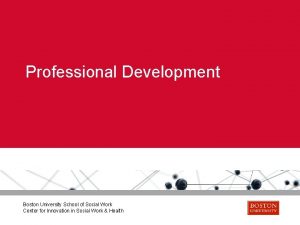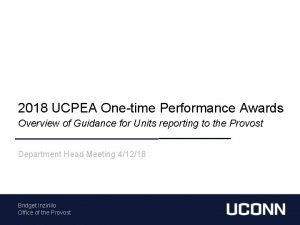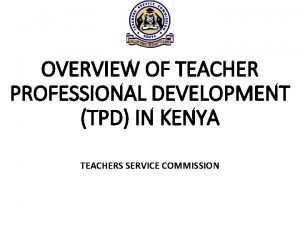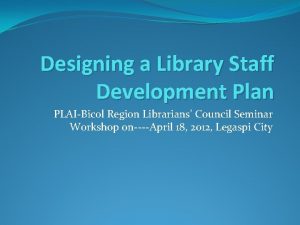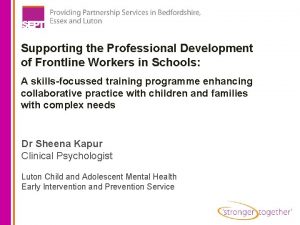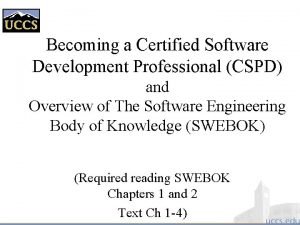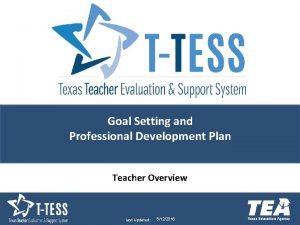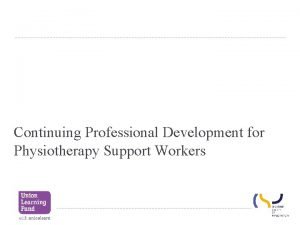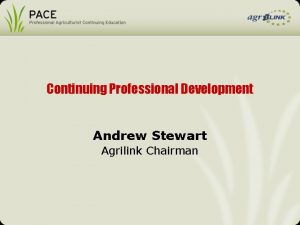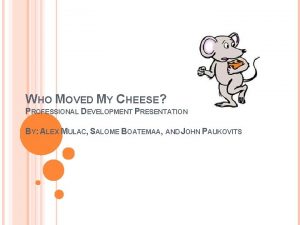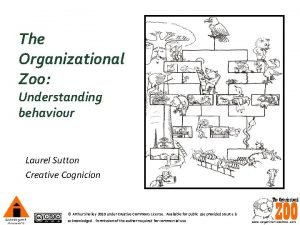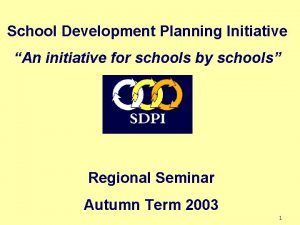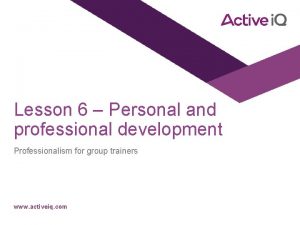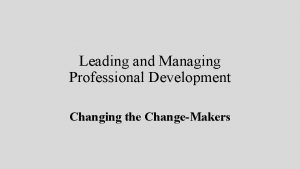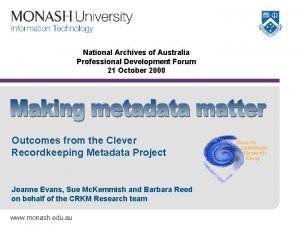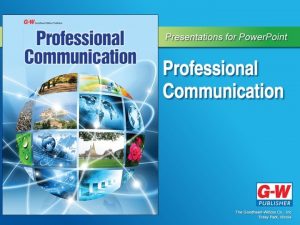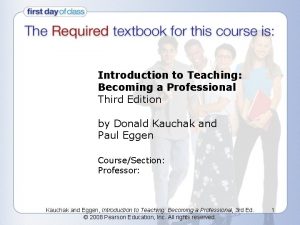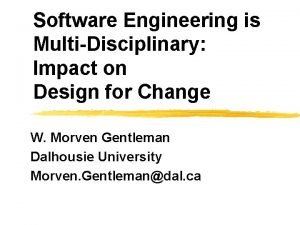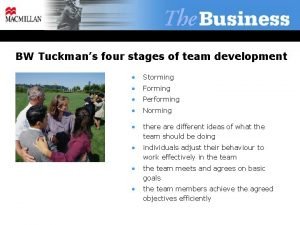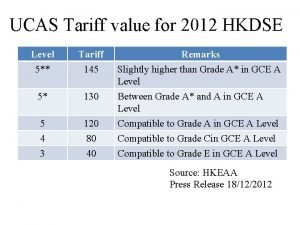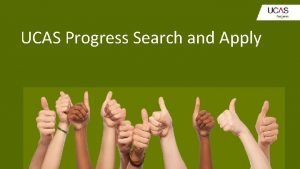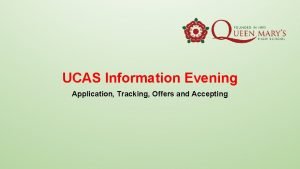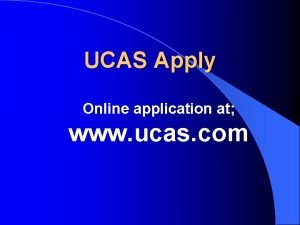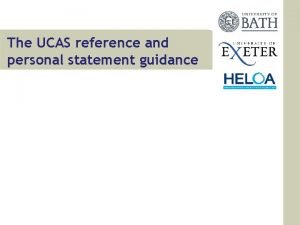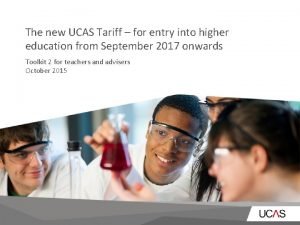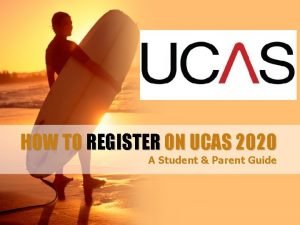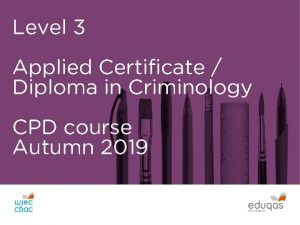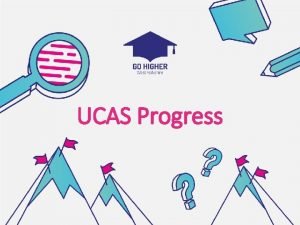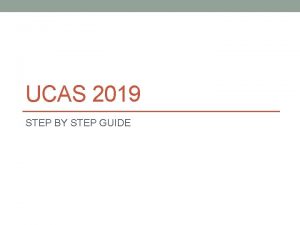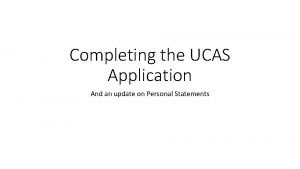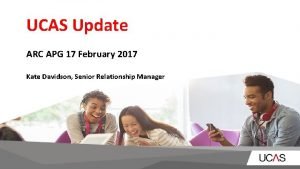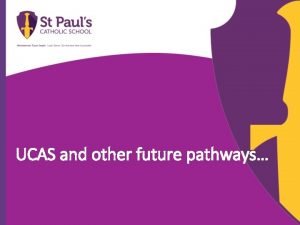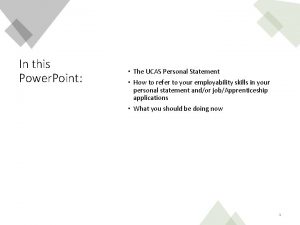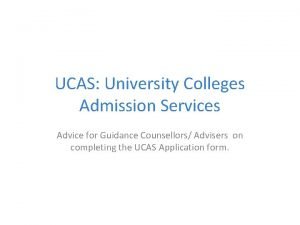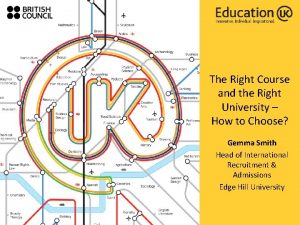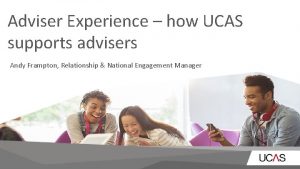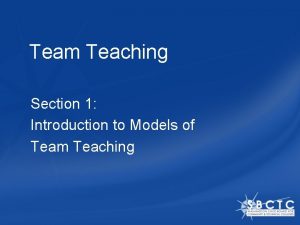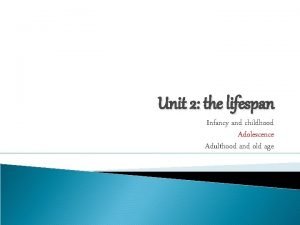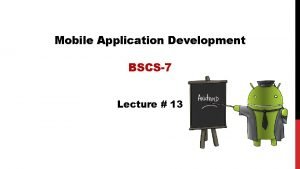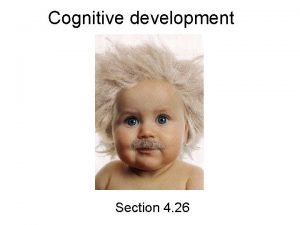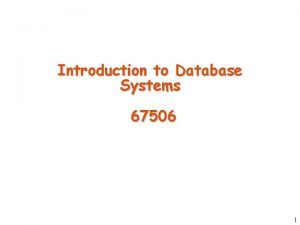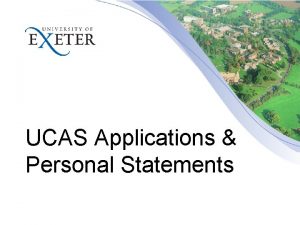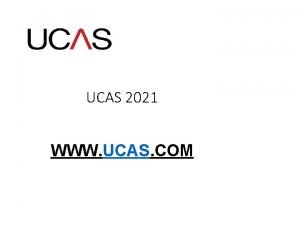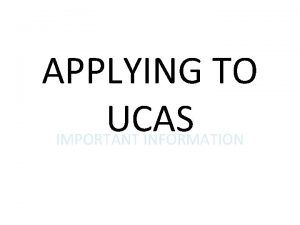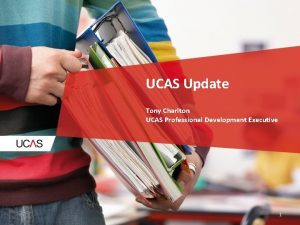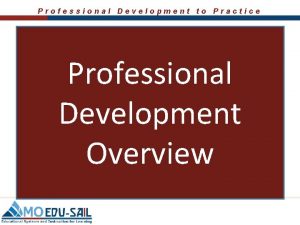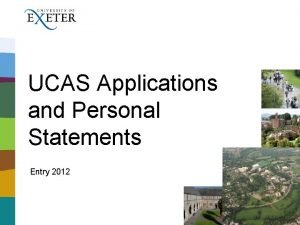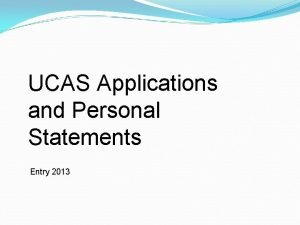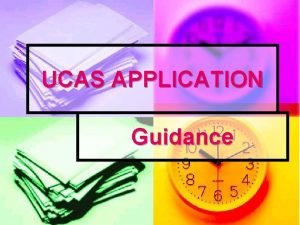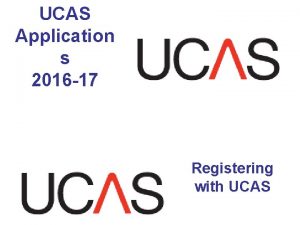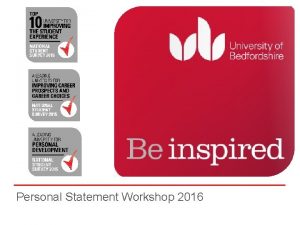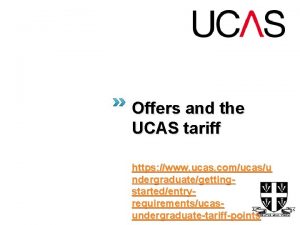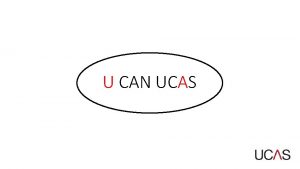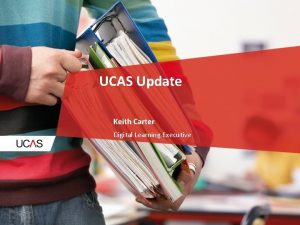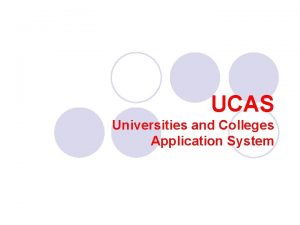Introduction to UCAS Professional Development Team UCAS quiz









































































- Slides: 73

Introduction to UCAS Professional Development Team

UCAS quiz ABL Awarding Body Linkage. CI Conditional Insurance UF Unconditional Firm DBD Decline by Default RBD Reject by Default RPA Record of prior acceptance SPA Supporting Professionalism in Admissions. UCC Confirmation decision with a change to either the course, year or point of entry. DCF Delayed confirmation decision ODL Outstanding decision List

UCAS Application Schemes • UCAS Undergraduate • UCAS Teacher Training • UCAS Conservatoires • UCAS Postgraduate • UCAS Progress

Welcome • Central service dates back to 1961, when UCCA was formed. • Independent organisation. • Registered charity. • Managed by an Executive Team and Board of Trustees.

Remit UCAS does: • process applications • provide information, advice and training • have a fraud and verification team • take part in education sector engagement UCAS doesn’t: • suggest courses or universities • make decisions or offers • advise on finance, immigration or visas for individuals

Providers 380 + universities/colleges • Four in Northern Ireland • 16 in Wales • 18 in Scotland • 348 in England • One European How many courses do you think this equates to?

What should I know? • Know your sector • Know your UCAS cycle • Know your applicants • Know your qualifications • Know your systems

Recent applicants and accepts • Highest ever demand for HE • Record number of offers made in 2015 (1. 9 m) • Record number of acceptances

Applicant statistics Statistics show • Peak in UK/EU applicant numbers 2010/2011 immediately prior to funding change • Expected drop in 2012 • Continued recovery through to new record high in 2015 • Likely to plateau in 2016 – see End of Cycle Report in December (on ucas. com)

Acceptance statistics Statistics show • UK students highest proportion of accepts • EU have been rising by largest amount proportionally (but what will effects of Brexit be? ) • Non-EU peak 2010 then drop 2011 – changes to Points Based System & visa requirements

Further 2015 cycle analysis • A record 18. 1% of the most-disadvantaged students placed • High, medium and lower tariff providers all accept more students • Higher tariff providers see biggest %age increase • Largest %age increase by subject group • • • Non-European Languages Veterinary Sciences, Agriculture and related; Education Engineering • Largest % age decrease by subject group • Combined Arts; Combined Sciences (Full statistics published on ucas. com/corporate)

2016 cycle applicant statistics 593, 720 total applicants (+<1%) England: 411, 420 (-1%) N. Ireland: 20, 040 (+2%) Scotland: 45, 100 (+1%) Wales: 21, 000 (+1%) EU: 42, 720 (+6%) Not EU: 52, 020(+1%)

2016 cycle statistical analysis January deadline application rates for 18 year olds by country Rates increase to new highs in: Rate in Northern Ireland England (37%) remains at 48% high. Scotland (33%) Wales (32%) This is a measure of ‘behavioural’ (rather than demographic) demand for HE.

The changing bigger picture - Qualification reforms. Variable fees. University rankings and ratings. Increased choice and market forces. Alternatives, such as Degree and Higher Apprenticeships. More information and advice. Fairness and diversity commitments. Changing architecture (creation of Office for Students; TEF)

Changes at UCAS - New UCAS. com went live end of September. Apprenticeship information and advice. Tariff 2017. Self service portal. Improved collection tools.

The UCAS Journey

Apply 2017 key facts • Application is entirely online. • Maximum of five choices. • Some choice restrictions: • medicine, veterinary science, dentistry (maximum of four) • Oxford or Cambridge • Simple application cost: • one choice – £ 13 • two to five choices – £ 24 • Equal consideration. • ‘Invisibility’.

Key dates 24 May 2016 – undergraduate Apply opens for 2017 entry. 6 September 2016 – completed applications can be submitted to UCAS. 15 October 2016 (18: 00 UK time) – deadline for Oxford or Cambridge, medicine, dentistry or veterinary science applications. 15 January 2017 (18: 00 UK time) – deadline for the majority of undergraduate courses. 24 March 2017 (18: 00 UK time) – deadline for some art and design courses. 30 June 2017 (18: 00 UK time) – last date to submit an application before Clearing.

Completing the UCAS application Six sections to complete: • • personal details additional information (UK only) choices education employment personal statement (Referee Details) tutor adds reference UCAS universities/colleges


Common applicant errors • Fail to check entry requirements or if they need to take admissions tests. • Qualifications are missing or incorrectly entered. • Inappropriate email address is used or email address is not verified. • Do not give details on disability, special needs or if they have been in care. • Tick some boxes (e. g. unspent criminal convictions) in error. • Fail to tick other boxes (e. g. section complete). • Do not know they have a 14 day CMA cool off period. • Forget password so get locked out.

Personal Statements • Independent study skills. • An understanding of the course. • Good numeracy and literacy. • Self-awareness. • Motivation and commitment. • Essay writing - don’t write lists! • Research skills. • Time management skills. • Enthusiasm- go beyond the syllabus. • Reflective thinking.

How can providers help? • Search tool • Consistent advice • Clear entry requirements

Once an application arrives at UCAS • Applications sent to UCAS are usually processed within 48 hours. • Processing includes various checks (for fraud and similarity). • Once an application has been processed, the applicant is given access to Track. • This allows them to follow the progress of and manage their application. • UCAS centres can subscribe to Adviser Track.

Track

Your decisions Universities and colleges will review the: • • personal statement reference qualifications admissions test results interviews portfolios auditions You’ll get 1 of 3 decisions: • Unconditional offer • Conditional offer • Unsuccessful ‘Withdrawal’, ‘Full’ and ‘Invitation’ are also available to you.

Offer making in 2015 • Providers increase offer-making by 4. 5% to 1. 9 million offers. • Over half of applicants with five choices have at least four offers. • Offer rate to 18 year olds from English providers up 0. 9% to 78%. • • • 65% of those predicted AAB received five offers. A record 32% of applicants with five choices received five offers. 98. 5% of those predicted BBB received at least one offer. (Full statistics published on ucas. com/corporate)

Conditional or unconditional Conditional An offer made dependant on meeting specific conditions, which can include both academic and non-academic conditions. Usually made up of grades, tariff points or a mixture of both. Unconditional An offer made when no further academic conditions have to be met. Can also include non-academic conditions.

The Official Offer The UCAS offer is the official offer • Conditions to be met by a certain date must be stated • If qualifications have to be met from one sitting it says so in offer/s • If resits are not accepted it says so in offer/s • Do not add a condition of “subject to interview” or similar Simplicity and accuracy • Offer making should be clear and concise. • Don’t over-complicate offers with too many variants and specifics. • Think how an offer will look to an applicant – should be unambiguous. • Applicant should be in no doubt about what’s required.

Systems and offers How does your institution process applications? • Main software houses • Internal system • UCAS web-link How does your system link with UCAS? • Daily deadlines • Gaps between issuing offer and applicant seeing it on Track

How can providers help? • • Incentivised offers Unconditional offers Predicted grades Unconscious bias Offers made outside UCAS RPAS CMA rules

Pair and share Discuss the following questions on your tables. Be prepared to feedback to the group. 1. What information does your institution review in offer making? 2. What is the effect of making offers that are lower that your published selection level? 3. Are you providing appropriate information to prospective students?

Applicant replies Wait for all decisions from all choices then they can choose one: • firm – if all conditions are met, where they will be placed • insurance – usually lower conditions in case the firm conditions are not met • Any other offers must be declined. • They don’t have to have an insurance. (14 day CMA cooling off period)

Reply deadlines Application submitted by: Last HEP decision received by: EU applicants reply by: Non-EU applicants reply by: 6 September to 15 January 31 March (Recommended) 4 May (DBD) 8 June (DBD) 5 May (RBD) 8 June (DBD) 16 January to 30 June 8 June (Recommended) 22 June (DBD) 13 July (RBD) 20 July (DBD) RBD – Rejection by Default (UCAS automatically rejects for university) DBD – Decline by Default (UCAS automatically declines for applicant)

Confirmation of places Exam results are published and (may be) sent to universities and colleges by UCAS. There are four possible outcomes: Met the conditions of your firm? Time to celebrate! Missed out on your firm, but met insurance conditions? Also time to celebrate! Not met the conditions of either? You could still get a place through Clearing. Done better than expected? You could use Adjustment to change your place to a more aspirational choice.

How can providers help? • • Ensuring that embargoes are NOT broken Circulating communications to all staff ABL Make decisions quickly

Embargoes Do NOT break the embargo!

Application summary 1 Applicant researches and chooses courses. 2 Registers online with UCAS Apply. 3 Completes form and processes payment. 4 Reference added by centre / independent referee. 5 Centre / applicant sends form electronically to UCAS. 6 UCAS processes application and sends to chosen provider. 7 Decisions made (offer or unsuccessful). 8 Applicant views decisions on Track. 9 Applicant replies to offers. 10 Place confirmed.

Other options Extra (25 Feb – 4 Jul) Used all five choices and had no offers (or declined all offers/withdrew). Add Extra choices for consideration one at a time. Clearing (early Jul to Oct) Apply after 30 June, receive no offers, decline all offers, or not met conditions. Adjustment (up to five days in Aug) Placed with firm choice and did better than conditional offer.

Clearing process • Places secured via Track. • A verbal agreement following initial direct contact must be made. • Eligible applicants will have a 10 digit Personal ID number (PID) and a 6 digit Clearing number. • Should be able to quote both to the universities they contact. Eligible applicant researches vacancies If unsuccessful applicantplaced can Applicant start again on course Universities and colleges consider application Contact providers to discuss application Applicant enters choice details on Track

Direct Contact Service • Trialed last year as ‘Precision Marketing Data Service’. • HEPs and (A level, BTEC or SQA) applicants can register to use. • UCAS ‘matches’ registered applicants in Clearing with registered providers and sent contact lists to providers to enable them to telephone applicants (from 12: 00 on A level results day onwards). • Applicants still using Clearing as previously, but could expect calls from up to five HEPs too.

Confirmation and Clearing • • Busiest time of the cycle with applicants on tenterhooks. Not all results will come to you through ABL. Not all qualifications have a single release date. SQA and A level results are received early (under embargo). Track and Adviser Track ‘frozen’ until publication days. Both are ‘unfrozen’ on the relevant publication days. Applicants /advisers expect to have Confirmation decisions then. Applicants expect decisions transactions to be immediate.

How can providers help? • • Ensure that staff are contactable over confirmation and clearing Ensure all staff, including temporary, are clear on the processes involved Advice given to learners needs to be clear and accurate If possible advise where there may be a delay in UCAS records being updated (and if possible give an indication on when this might happen)

Several routes to success There are six main routes for an applicant to be accepted through UCAS. Match the following routes to their correct coloured line on the large sheet: Firm Insurance Extra Adjustment Clearing (applied after 30 June) Clearing (applied before 30 June)

Lunch

15 October 15 15 January Number 5 of initial choices HE providers in 380+ undergraduate scheme Number of choices for medic 4 ine (+ dentistry & veterinary) Offers held 2 (firm & insurance) 31 31 August CMA “cooling 14 off” period New tariff points 56 for A* A Level 24 March/ 24 plication 2017 ap Max. number of charac 4000 ters (PS & fee reference)

Qualifications Translation Game First Level Degree (France) Licence Bachelor degree (Ukraine) Диплом бакалавра Master’s Degree (Lithuania) Magitras First Cycle Degree (Finland) tekniikan kandidaatti Secondary School Exit Exam (Denmark) Studentereksamen Undergraduate Degree (Spain) Título de grado Bachelor’s Degree (Romania) Bachelor Degree (Russia) Diploma de licenta степень бакалавра Secondary School Diploma (Turkey) Lise Diplomasi Secondary School Leaving Exam (Austria) Reifeprüfung Bachelor Degree (China) 学士学位 Senior Secondary Graduation (Japan) 上級副卒業

Know your qualifications Welsh Baccalaureate BTEC OU credits International Foundation Year Advanced Highers GCSE Extended Project A levels IB Indian Standard Welsh XII Cambridge Pre NVQ Baccalaureate APs -U OCR National HNCs/HNDs AQA Scottish Highers Irish Leaving Certificate Baccalaureate

Acceptance rates for UK 18 year olds by type of qualification held Source: Figure 104 from ‘UCAS End of Cycle Report 2015’

Increase in acceptances holding BTECs English accepted applicants of all ages: 2008 - 2015

Science practical England New core maths - England Decoupled AS England New A levels – England, Wales, NI GCSEs – Wales (Maths) and NI New Welsh Bacc Wales New GCSEs England New Nationals - Scotland New Highers Advanced Highers - Scotland VQ reform England Increased use of VQs and declining 18 year old population Coupled AS – Wales and NI

We are here

The UK picture – A levels Open market – coupled and decoupled. Science practical embedded. Decoupled. Separate science practical grade. Coupled. Science practical grade embedded.

The UK picture – GCSEs National 4 -5 Open market – 9 -1 and A* to U 9 -1 grading A* - U grading.

Know your qualifications Increasing diversity of qualifications means a significant number of UCAS applicants will not have A levels. • • Qualification reform is ongoing. Range of qualifications within and across the UK. Challenging to manage mixed model of old and new qualifications. Rise of the vocational qualifications for access to HE. Increased mixed qualification profiles. European qualifications. International qualifications. Changing progression pathways.

Challenges for admissions staff • Managing the volume of change, especially from 2017. • Maintaining fair and transparent admissions is paramount. • Fewer “standard” applications makes the process of admissions more demanding and time-consuming. • Loss of reliance on historic evidence base; will take years to rebuild offer-making strategies. • Treatment of GCSEs, AS and A levels from England, Wales and NI. • Narrowing of curriculum breadth and subject choice: • impacts on widening participation. • information and advice will need to be stronger.

Know your qualifications You’ll never know it all, so utilise the full range of information sources available. • New Digital QIPs. • Qualification Reform: a guide to what is happening around the UK. • Progression Pathways Report. • Unpacking qualification reform UCAS A level. survey – January 2016 update. • Colleagues’ body of experience and expertise. • Established internal university equivalences. • UK NARIC.

Qualification reform statements • Clear demand from schools and colleges about how HEPs will accommodate the changing landscape. • Recommendation is that all universities and colleges produce Qualification reform statements. • These are hosted on UCAS. com.

New Tariff for 2017 entry New Tariff points are determined by multiplying size and grade bands size x grade Size bands – allocated 1 to 4, based on a qualification’s guided learning hours Grade bands – allocated 3 to 14 spread across the breadth of Level 3 / SCQF Level 6

New Tariff for 2017 entry

New Tariff – Size bands Size band 1 2 3 4 GLH/NLH < 120 -219 220 -319 320+ Qualifications included Free Standing Mathematics Qualifications GLH/NLH 60 IB Theory of Knowledge 100 IB Extended Essay Extended Project Qualification 100 120 AS 180 BTEC (QCF) L 3 Certificate 180 IB Standard Certificate Scottish Higher Scottish Advanced Higher 200 240 320 A level 360 IB Higher Certificate 360 BTEC (QCF) L 3 Subsidiary Diploma 360 Pre U Principal Subject 380

New Tariff – Grade bands Grade band A level AS Scottish Highers (New Tariff) 14 13 12 11 10 9 8 7 6 5 4 3 Scottish Adv Highers A* A A B A C B D C D E E D

How can providers help? • Transparency over entry requirements • Qualification Reform statements • Take part in annual survey to suggest which qualifications need to be Tariffed

Fraud and verification

The UCAS Verification Unit • Dedicated team of 8 FTE members plus Coordinator • Screen ALL applications across HUNTER • Issue Hunter alerts on UCAS website • Screen personal statements across COPYCATCH • Conduct individual investigation of suspicious applications and cancel where appropriate

Risk assessment Higher risk: Lower risk: § § § Those under 21 years of age Those still in full-time education Those awaiting exam results via ABL Those with an academic reference Those with a complete application Those applying by the relevant deadline § § § Those over 21 years of age Those not in full-time education Those not awaiting exam results via ABL Those with a non- academic reference Those with an incomplete application Those applying late in the cycle

Detecting fraud Is the application complete? ▫ Not all questions are compulsory ▪ Is the application timely? ▫ Fraudsters have been targeting late in the cycle ▪ Are all the dates and details consistent? ▫ Fraudulent applications usually contain fictitious elements ▫ Check that everything hangs together ▫ If suspicious, check copies of as many documents as possible as it is more difficult to remain consistent across a range of documents. ▪ Are the personal statement and reference suspiciously similar? ▫ Fictitious referees and references are not unusual – and applicants do sometimes try and write their own reference ▪

What is wrong with these documents? If a document is original then there is no need to state it. Crest is incorrect and misaligned Cape of Good Hope (Hoop is Afrikaans) Signatures Scanned in

Similarity Detection Service Each personal statement is checked against: ▪ a library of personal statements previously submitted to UCAS ▪ sample statements collected from a variety of websites ▪ other sources, including paper publications Each personal statement received at UCAS is added to the library of statements after it has been processed.


Preventing fraud ▪ Acknowledge the problem ▪ Formulate a strategy ▪ Provide resources ▪ Provide training ▪ Inform applicants ▪ Warn applicants

Resources for you Admissions Guide Digital QIPs Provider Section of Website SPA best practice toolkits

Final questions Thank you for listening and joining in. HEP Team Tel: 0344 984 1111 Email: hep_team@ucas. ac. uk Data Collection Team Tel: 01242 544 864 Email: coursesdata@ucas. ac. uk UCAS Professional Development training@ucas. ac. uk
 Going native project management
Going native project management Team spirit becomes team infatuation
Team spirit becomes team infatuation The white team cheers for the blue team, just like
The white team cheers for the blue team, just like Professional writing quiz
Professional writing quiz Social work boundaries quiz
Social work boundaries quiz Quiz team x 2
Quiz team x 2 R.a. no. 10912 was signed into law on?
R.a. no. 10912 was signed into law on? 7 norms of collaboration
7 norms of collaboration Pdp early childhood education and training program
Pdp early childhood education and training program Teacher professional development plan examples
Teacher professional development plan examples Manage personal and professional development
Manage personal and professional development Norms for professional development
Norms for professional development Ppst domain 7
Ppst domain 7 What is community linkages and professional engagement
What is community linkages and professional engagement 4 stages of professional development
4 stages of professional development Ucpea professional development
Ucpea professional development Professional development pathway
Professional development pathway Kenya professional teaching standards
Kenya professional teaching standards Navy medicine professional development center
Navy medicine professional development center Manage personal and professional development
Manage personal and professional development Cuny professional development conference
Cuny professional development conference Library staff development plan sample
Library staff development plan sample Grraacceess
Grraacceess Quote on professional development
Quote on professional development Professional development
Professional development Initial professional development
Initial professional development Certified software development professional
Certified software development professional Teacher professional development plan template texas
Teacher professional development plan template texas Continuing professional development
Continuing professional development Continuing professional development
Continuing professional development Continuing professional development
Continuing professional development Ccsd professional development
Ccsd professional development Who moved my cheese presentation
Who moved my cheese presentation The professional development group
The professional development group Professional development for teachers
Professional development for teachers Personal and professional development level 6
Personal and professional development level 6 Managing professional development
Managing professional development Professional development forum
Professional development forum Anything that prevents clear, effective communication
Anything that prevents clear, effective communication Introduction to teaching 6th edition
Introduction to teaching 6th edition Every quiz has been easy. therefore, the quiz will be easy
Every quiz has been easy. therefore, the quiz will be easy Every quiz has been easy therefore the quiz will be easy
Every quiz has been easy therefore the quiz will be easy Norming storming forming performing
Norming storming forming performing Multidisciplinary engineering definition
Multidisciplinary engineering definition Norming stage
Norming stage Tuckmans stages
Tuckmans stages Hkdse to a level
Hkdse to a level Ucasprogress
Ucasprogress Ucas tracking
Ucas tracking Ucas apply online
Ucas apply online Ucas reference example
Ucas reference example Ucas points calculator old
Ucas points calculator old Personal statement tool
Personal statement tool Ucas 2020 login
Ucas 2020 login Criminology unit 3 controlled assessment
Criminology unit 3 controlled assessment Ucas progress
Ucas progress Ucas adviser
Ucas adviser Deadline for ucas 2019
Deadline for ucas 2019 Nominated access ucas
Nominated access ucas Ucas embargo
Ucas embargo Ucas
Ucas Ucas pointd
Ucas pointd Ucas
Ucas Conservatoires ucas
Conservatoires ucas 420 ucas points
420 ucas points Ucas for advisers
Ucas for advisers What is team teaching
What is team teaching Quiz 1: early development of industry
Quiz 1: early development of industry Section quiz 4-2 personal development
Section quiz 4-2 personal development Mobile application development quiz
Mobile application development quiz Theory of mind
Theory of mind Hand tool quiz
Hand tool quiz Introduction to database quiz
Introduction to database quiz 2-6 additional practice the quadratic formula
2-6 additional practice the quadratic formula




